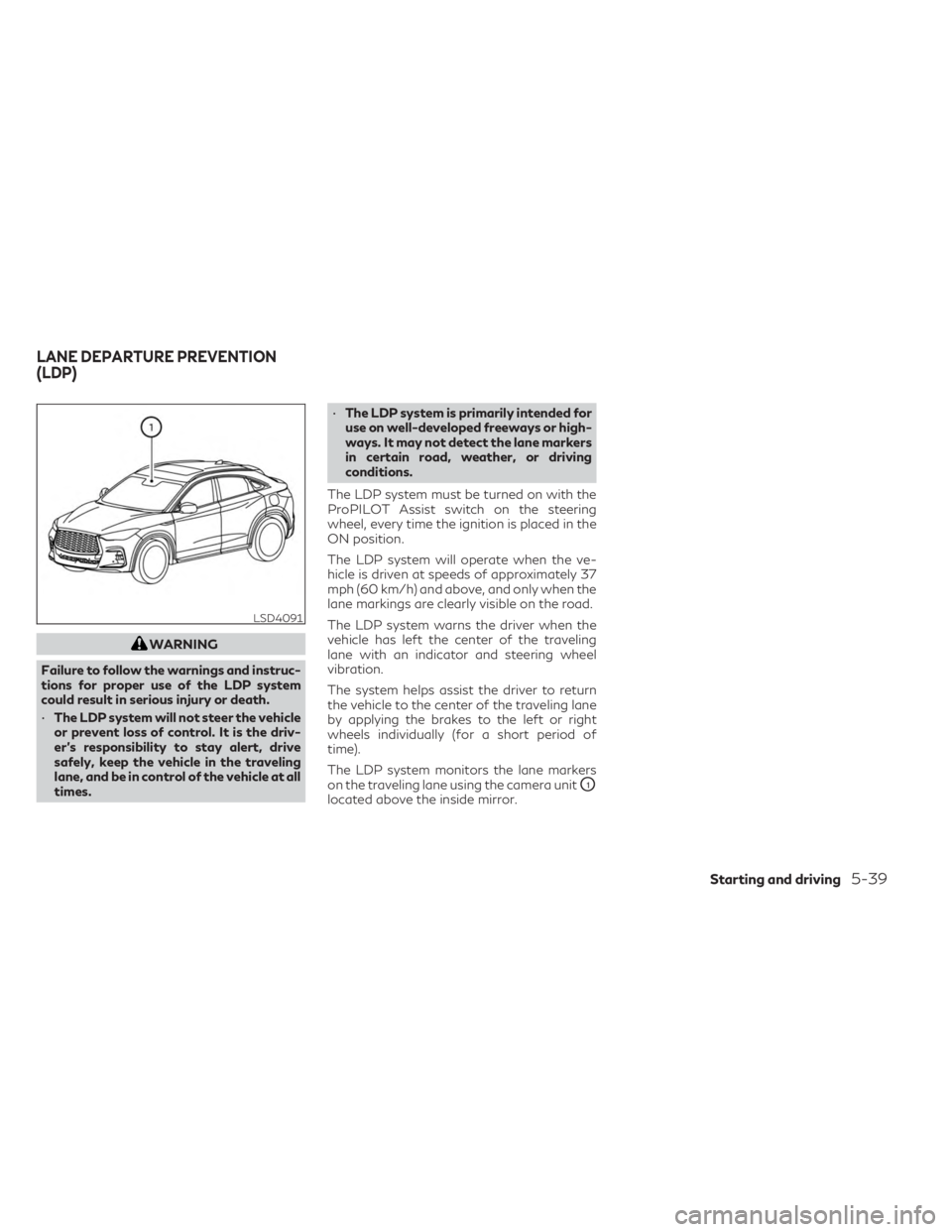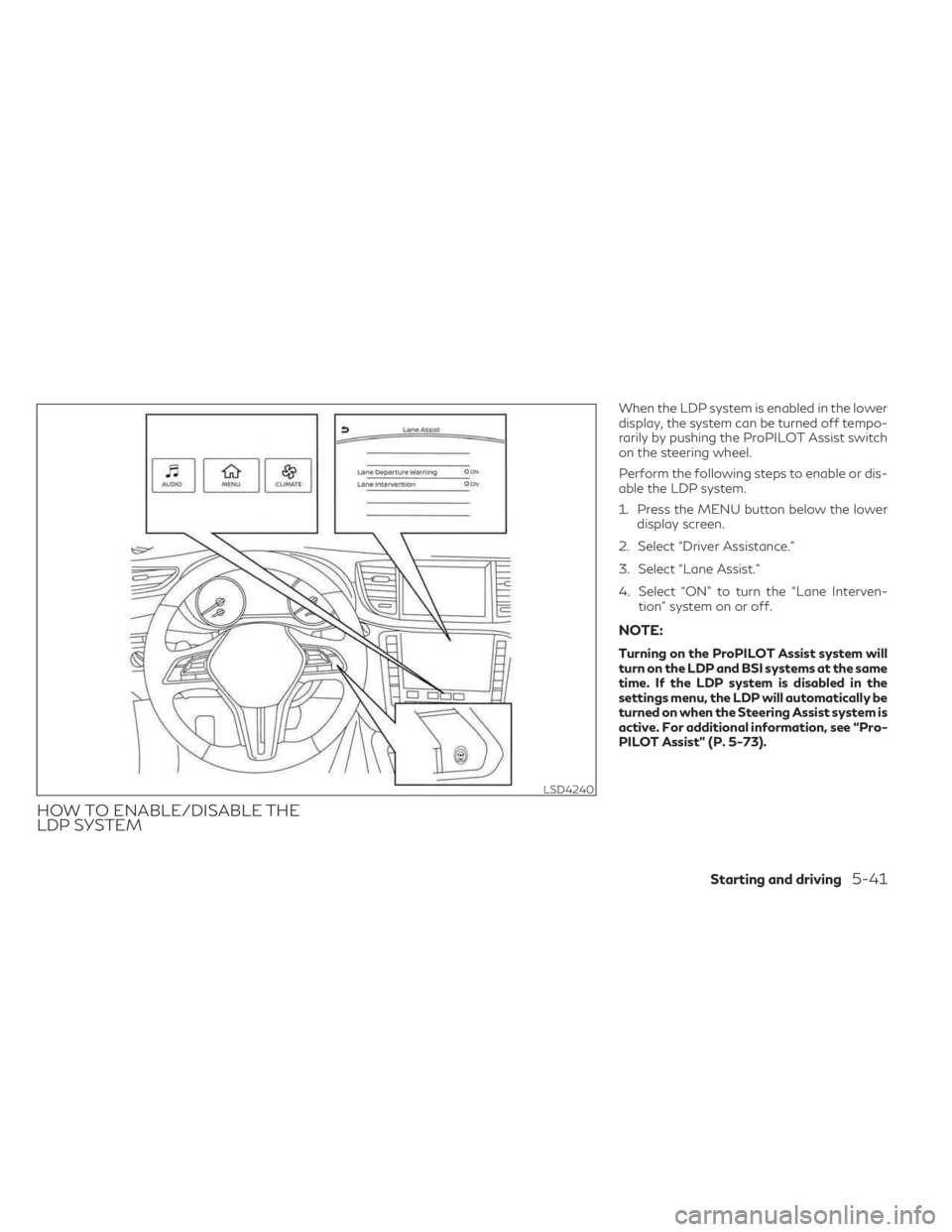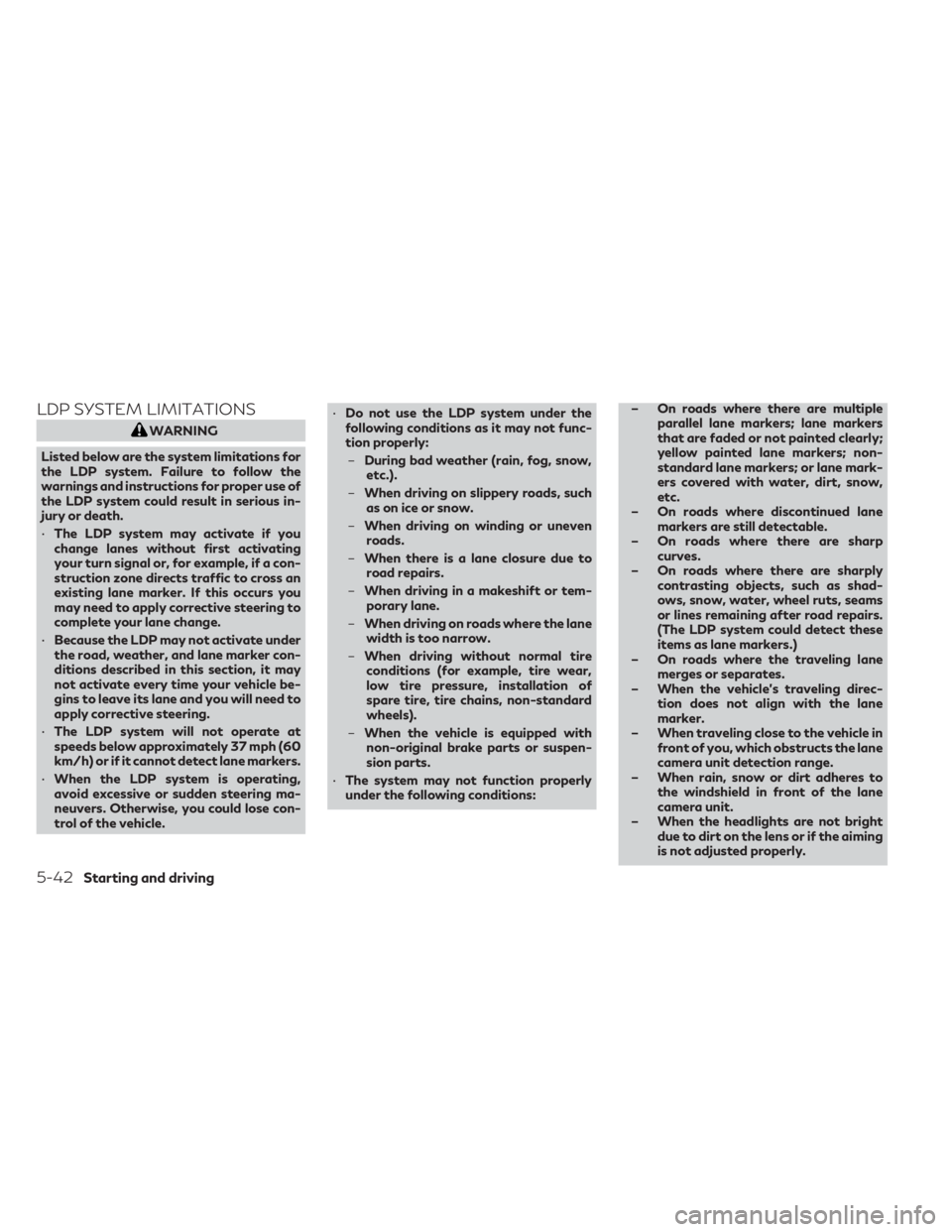steering wheel INFINITI QX55 2023 Service Manual
[x] Cancel search | Manufacturer: INFINITI, Model Year: 2023, Model line: QX55, Model: INFINITI QX55 2023Pages: 526, PDF Size: 5.75 MB
Page 258 of 526

•When a wheel is off the ground due to an
unlevel surface, do not spin the wheel
excessively.
• Accelerating quickly, sharp steering ma-
neuvers or sudden braking may cause
loss of control.
• If at all possible, avoid sharp turning ma-
neuvers, particularly at high speeds.
Your INFINITI vehicle has a higher center
of gravity than a passenger car. The ve-
hicle is not designed for cornering at the
same speeds as passenger cars. Failure
to operate this vehicle correctly could re-
sult in loss of control and/or a rollover
accident.
• Always use tires of the same type, size,
brand, construction (bias, bias-belted, or
radial), and tread pattern on all four
wheels. Install tire chains on the front
wheels when driving on slippery roads
and drive carefully.
• Be sure to check the brakes immediately
after driving in mud or water. For addi-
tional information, see “Brake precau-
tions” (P. 5-139).
• Avoid parking your vehicle on steep hills.
If you get out of the vehicle and it rolls
forward, backward or sideways, you
could be injured. •
Whenever you drive off-road through
sand, mud or water as deep as the wheel
hub, more frequent maintenance may be
required. For additional information, see
“Additional maintenance items for se-
vere operating conditions” (P. 9-7).
INTELLIGENT ALL-WHEEL
DRIVE (AWD) DRIVING SAFETY
PRECAUTIONS (if so equipped)
WARNING
• Replacing tires with those not originally
specified by INFINITI could affect the
proper operation of the TPMS.
• Always use tires of the same type, size,
brand, construction (bias, bias-belted or
radial), and tread pattern on all four
wheels. Install tire chains on the front
wheels when driving on slippery roads
and drive carefully.
• This vehicle is not designed for off-road
(rough road) use. Do not drive on sandy
or muddy roads that tires may get stuck
in. •
For AWD equipped vehicles, do not at-
tempt to raise two wheels off the ground
and shift the transmission to any D
(Drive) or R (Reverse) position with the
engine running. Doing so may result in
drivetrain damage or unexpected vehicle
movement which could result in serious
vehicle damage or personal injury.
• Do not attempt to test an AWD
equipped vehicle on a 2-wheel dyna-
mometer (such as the dynamometers
used by some states for emissions test-
ing) or similar equipment even if the
other two wheels are raised off the
ground. Make sure you inform test facil-
ity personnel that your vehicle is
equipped with AWD before it is placed
on a dynamometer. Using the wrong test
equipment may result in drivetrain dam-
age or unexpected vehicle movement
which could result in serious vehicle dam-
age or personal injury.
• When a wheel is off the ground due to an
unlevel surface, do not spin the wheel
excessively.
5-12Starting and driving
Page 268 of 526

Manual shift mode
The transmission enters the manual shift
mode by moving the shift lever again to the D
(Drive) position when the vehicle is in the D
range.
You can select the manual shift range by
pulling the left side or right side paddle shifter
OAandOB. To cancel the manual shift mode,
move the shift lever to the D (Drive) position
again. The transmission returns to the auto-
matic drive mode.
When the shift lever is shifted from D (Drive)
to the manual shift mode with the vehicle stopped or while driving, the transmission
enters the manual shift mode. Shift ranges
can be selected manually. Shift ranges can
also be selected using the paddle shifters on
the steering wheel. When you pull the paddle
shifter while in the D (Drive) position, the
transmission will shift to the upper or lower
range temporarily. If the paddle shifters are
not used for about 5–10 seconds, the trans-
mission will automatically return to the D
(Drive) position. If you want to return to the D
(Drive) position manually, pull and hold either
paddle shifter for about 1.5 seconds.In the manual shift mode, the shift range is
displayed on the position indicator in the me-
ter. When moving the shift lever to the
manual shift mode, the position indicator dis-
plays 1 (1st) up to 8 (8th) depending on ve-
hicle speed.
Shift ranges up or down one by one as
follows:
1⇔
2⇔ 3⇔ 4⇔ 5⇔ 6⇔ 7⇔ 8
8 (8th)
Use this position for all normal forward driv-
ing at highway speeds.
7 (7th), 6 (6th) and 5 (5th)
Use this position when driving up long slopes,
or for engine braking when driving down long
slopes.
4 (4th), 3 (3rd) and 2 (2nd)
Use these positions for hill climbing or engine
braking on downhill grades.
1 (1st)
Use this position when climbing steep hills
slowly or when driving slowly, or for maxi-
mum engine braking on steep downhill
grades.
LSD4197
Manual shift gate
LSD2914
Paddle shifters
5-22Starting and driving
Page 280 of 526

SYSTEM MAINTENANCE
The TSR system uses the same multi-sensing
front camera unit that is used by the Lane
Departure Warning (LDW) system, located in
front of the interior rearview mirror. For ad-
ditional information, see ”System mainte-
nance” (P. 5-38).
WARNING
Failure to follow the warnings and instruc-
tions for proper use of the LDW system
could result in serious injury or death.
• This system is only a warning device to
inform the driver of a potential unin-
tended lane departure. It will not steer
the vehicle or prevent loss of control. It is
the driver’s responsibility to stay alert,
drive safely, keep the vehicle in the trav-
eling lane, and be in control of the vehicle
at all times. The LDW system will operate when the ve-
hicle is driven at speeds of approximately 37
mph (60 km/h) and above, and only when the
lane markings are clearly visible on the road.
The LDW system monitors the lane markers
on the traveling lane using the camera unit
O1
located above the inside mirror.
The LDW system warns the driver with an
indicator in the vehicle information display
and the steering wheel will vibrate, indicating
that the vehicle is beginning to leave the driv-
ing lane. For additional information, see
“LDW system operation” (P. 5-35).
LSD4091
LANE DEPARTURE WARNING (LDW)
5-34Starting and driving
Page 281 of 526

LDW SYSTEM OPERATION
The LDW system provides a lane departure
warning function when the vehicle is driven at
speeds of approximately 37 mph (60 km/h)
and above and the lane markings are clear.
When the vehicle approaches either the left
or the right side of the traveling lane, the
steering wheel will vibrate and the LDW indi-
cator on the instrument panel will blink to
alert the driver.
The warning function will stop when the ve-
hicle returns inside of the lane markers.
LSD3040
Starting and driving5-35
Page 285 of 526

WARNING
Failure to follow the warnings and instruc-
tions for proper use of the LDP system
could result in serious injury or death.
• The LDP system will not steer the vehicle
or prevent loss of control. It is the driv-
er’s responsibility to stay alert, drive
safely, keep the vehicle in the traveling
lane, and be in control of the vehicle at all
times. •
The LDP system is primarily intended for
use on well-developed freeways or high-
ways. It may not detect the lane markers
in certain road, weather, or driving
conditions.
The LDP system must be turned on with the
ProPILOT Assist switch on the steering
wheel, every time the ignition is placed in the
ON position.
The LDP system will operate when the ve-
hicle is driven at speeds of approximately 37
mph (60 km/h) and above, and only when the
lane markings are clearly visible on the road.
The LDP system warns the driver when the
vehicle has left the center of the traveling
lane with an indicator and steering wheel
vibration.
The system helps assist the driver to return
the vehicle to the center of the traveling lane
by applying the brakes to the left or right
wheels individually (for a short period of
time).
The LDP system monitors the lane markers
on the traveling lane using the camera unit
O1
located above the inside mirror.
LSD4091
LANE DEPARTURE PREVENTION
(LDP)
Starting and driving5-39
Page 286 of 526

LDP SYSTEM OPERATION
1. LDP indicator
2. Lower display buttons3. ProPILOT Assist switch
4. LDP ON indicatorThe LDP system operates above approxi-
mately 37 mph (60 km/h). When the vehicle
approaches either the left or the right side of
the traveling lane, the steering wheel will vi-
brate and the LDP indicator (orange) on the
instrument panel will blink to alert the driver.
Then, the LDP system will automatically ap-
ply the brakes for a short period of time to
help assist the driver to return the vehicle to
the center of the traveling lane.
To turn on the LDP system, push the ProPI-
LOT Assist switch on the steering wheel af-
ter starting the engine. The LDP ON indicator
on the instrument panel will illuminate. Push
the ProPILOT Assist switch on the steering
wheel again to turn off the LDP system. The
LDP ON indicator will turn off.
LSD3896
5-40Starting and driving
Page 287 of 526

HOW TO ENABLE/DISABLE THE
LDP SYSTEM
When the LDP system is enabled in the lower
display, the system can be turned off tempo-
rarily by pushing the ProPILOT Assist switch
on the steering wheel.
Perform the following steps to enable or dis-
able the LDP system.
1. Press the MENU button below the lowerdisplay screen.
2. Select “Driver Assistance.”
3. Select “Lane Assist.”
4. Select “ON” to turn the “Lane Interven- tion” system on or off.
NOTE:
Turning on the ProPILOT Assist system will
turn on the LDP and BSI systems at the same
time. If the LDP system is disabled in the
settings menu, the LDP will automatically be
turned on when the Steering Assist system is
active. For additional information, see “Pro-
PILOT Assist” (P. 5-73).
LSD4240
Starting and driving5-41
Page 288 of 526

LDP SYSTEM LIMITATIONS
WARNING
Listed below are the system limitations for
the LDP system. Failure to follow the
warnings and instructions for proper use of
the LDP system could result in serious in-
jury or death.
• The LDP system may activate if you
change lanes without first activating
your turn signal or, for example, if a con-
struction zone directs traffic to cross an
existing lane marker. If this occurs you
may need to apply corrective steering to
complete your lane change.
• Because the LDP may not activate under
the road, weather, and lane marker con-
ditions described in this section, it may
not activate every time your vehicle be-
gins to leave its lane and you will need to
apply corrective steering.
• The LDP system will not operate at
speeds below approximately 37 mph (60
km/h) or if it cannot detect lane markers.
• When the LDP system is operating,
avoid excessive or sudden steering ma-
neuvers. Otherwise, you could lose con-
trol of the vehicle. •
Do not use the LDP system under the
following conditions as it may not func-
tion properly:
– During bad weather (rain, fog, snow,
etc.).
– When driving on slippery roads, such
as on ice or snow.
– When driving on winding or uneven
roads.
– When there is a lane closure due to
road repairs.
– When driving in a makeshift or tem-
porary lane.
– When driving on roads where the lane
width is too narrow.
– When driving without normal tire
conditions (for example, tire wear,
low tire pressure, installation of
spare tire, tire chains, non-standard
wheels).
– When the vehicle is equipped with
non-original brake parts or suspen-
sion parts.
• The system may not function properly
under the following conditions: – On roads where there are multiple
parallel lane markers; lane markers
that are faded or not painted clearly;
yellow painted lane markers; non-
standard lane markers; or lane mark-
ers covered with water, dirt, snow,
etc.
– On roads where discontinued lane markers are still detectable.
– On roads where there are sharp curves.
– On roads where there are sharply contrasting objects, such as shad-
ows, snow, water, wheel ruts, seams
or lines remaining after road repairs.
(The LDP system could detect these
items as lane markers.)
– On roads where the traveling lane merges or separates.
– When the vehicle’s traveling direc- tion does not align with the lane
marker.
– When traveling close to the vehicle in front of you, which obstructs the lane
camera unit detection range.
– When rain, snow or dirt adheres to the windshield in front of the lane
camera unit.
– When the headlights are not bright due to dirt on the lens or if the aiming
is not adjusted properly.
5-42Starting and driving
Page 289 of 526

– When strong light enters the lanecamera unit. (For example, the light
directly shines on the front of the ve-
hicle at sunrise or sunset.)
– When a sudden change in brightness occurs. (For example, when the ve-
hicle enters or exits a tunnel or under
a bridge.)
While the LDP system is operating, you may
hear a sound of brake operation. This is nor-
mal and indicates that the LDP system is
operating properly.
SYSTEM TEMPORARILY
UNAVAILABLE
Condition A:
The warning and assist functions of the LDP
system are not designed to work under the
following conditions:
• When you operate the lane change signal and change the traveling lanes in the direc-
tion of the signal. (The LDP system will be
deactivated for approximately 2 seconds
after the lane change signal is turned off.)
• When the vehicle speed lowers to less than approximately 37 mph (60 km/h). After the above conditions have finished and
the necessary operating conditions are satis-
fied, the warning and assist functions will
resume.
Condition B:
The assist function of the LDP system is not
designed to work under the following condi-
tions (warning is still functional):
• When the brake pedal is depressed.
• When the steering wheel is turned as far as
necessary for the vehicle to change lanes.
• When the vehicle is accelerated during LDP system operation.
• When the Intelligent Cruise Control (ICC) approach warning occurs.
• When the hazard warning flashers are operated.
• When driving on a curve at high speed.
After the above conditions have finished and
the necessary operating conditions are satis-
fied, the LDP system application of the
brakes will resume. Condition C:
If the following messages appear in the ve-
hicle information display the LDP system will
be turned off automatically:
• “Not Available Poor Road Conditions”:
When the VDC system (except Traction
Control System [TCS] function) or ABS
operates.
• “Currently not available”: When the VDC system is turned off.
Action to take:
When the above conditions no longer exist,
turn off the LDP system. Push the ProPILOT
Assist switch on the steering wheel again to
turn the LDP system back on.
Temporary disabled status at high
temperature:
If the vehicle is parked in direct sunlight under
high temperature conditions (over approxi-
mately 104°F [40°C]) and then the LDP sys-
tem is turned on, the LDP system may be
deactivated automatically and the following
message will appear on the vehicle informa-
tion display: “Not available: High Camera
Temp.” When the interior temperature is re-
duced, the system will resume operating
automatically.
Starting and driving5-43
Page 302 of 526

•The BSI system is typically activated ear-
lier than the Lane Departure Prevention
(LDP) system when your vehicle is ap-
proaching a lane marker.
The BSI system turns on when the ProPILOT
Assist switch on the steering wheel, is pushed
when the “Blind Spot Intervention” is enabled
in the “Driver Assistance” menu in the lower
display. The BSI ON indicator on the instru-
ment panel illuminates when the BSI system
is turned on. The BSI system provides a chime
and turns on or flashes the side indicator light
even if the BSW system is off.
HOW TO ENABLE/DISABLE THE
BSI SYSTEMWhen the BSI system is enabled in the lower
display, the system can be turned off tempo-
rarily by pushing the ProPILOT Assist switch
on the steering wheel.
LSD3936
5-56Starting and driving